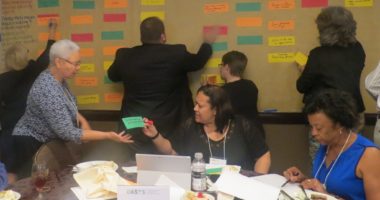Celebrating Hispanic Heritage Month
Today marks Chile’s Independence Day and the first full week of Hispanic Heritage Month celebration — a time when classrooms around the country become venues steeped in the rich traditions, culture, and history of places as far away as Tierra del Fuego and the Iberian Peninsula and as near as the borderlands shared by Mexico and the United States. It was nearly 50 years ago that President Lyndon B. Johnson signed Hispanic Heritage Week into law, and nearly 30 years ago that President Ronald Reagan extended the week to a month. In that time, classrooms have become increasingly diverse, so much so that Hispanic population growth is now the driving force behind the “new education majority” in the nation’s public schools.
In tandem with this growth, there is great cause for celebration. By nearly every measure — from reading and math performance to AP participation, high school graduation rates to enrollment — achievement for Latinos students has risen over time. But there is still much to be done to make sure Latino students get high quality education experiences that will enable them to be successful in college, the workplace, and society. This means getting serious about tackling the persistent disparities that separate Latino students from their White peers, including lower levels of funding K-12 schools, less access to strong, well-supported, and diverse teachers, crushing college costs that rest most heavily on Latino and other underrepresented students, and skewed enrollment patterns at postsecondary institutions.
- In a report on Latino teachers, you will hear about their classroom experiences and their ability to close the cultural divide between educators and Latino students as well as the daily hurdles they often face as the result of institutional biases.
- From Ed Trust-West, there will be an update on the Golden State’s Latino student population — the 1.3 million young people of preschool age, the 3.3 million Latinos in K-12 schools, and the 1 million who are enrolled in a college or university. As the report notes, it’s a diverse group that often ends up in segregated schools, taking courses that lack academic rigor, and at the college level, in remediation programs that hinder instead of help.
- Also in the coming weeks, a report on Latino student success examines graduation rates at hundreds of colleges and universities, learning in the process that comparable institutions can have widely disparate outcomes when it comes to college completion rates for Latino students. The report’s findings suggest that every institution, regardless of the students they serve, can have equitable graduation outcomes for Latino students.
As we celebrate Hispanic Heritage Month, it’s critical that we celebrate the gains Latino students and communities have made and tackle the inequities that remain. Our hope is these forthcoming resources will help educators, advocates, and policymakers do just that. If we are to ensure that all students reach their full potential, we have to look closely at these disparities — what’s behind them and what can we do to fix them. That’s what you can expect from The Education Trust in the coming months.







